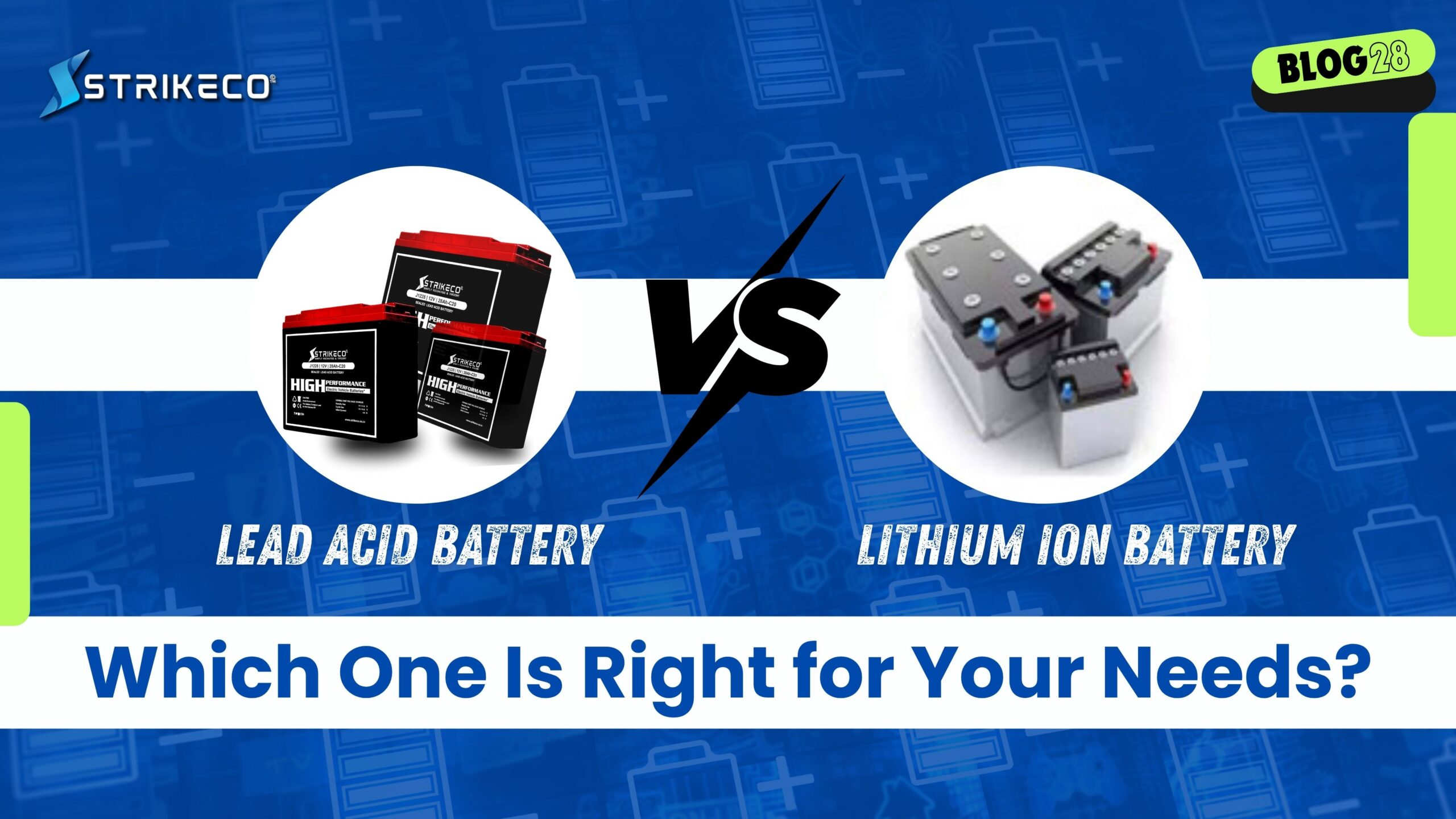
Lead Acid vs Lithium-Ion Batteries: Which One Is Right for Your Needs?
From electric vehicles to home power backup systems, the way India powers up is rapidly evolving. Whether you’re buying a new energy solution or upgrading your current setup, one critical decision stands out: should you choose a lead-acid battery or a lithium-ion battery?
Both battery technologies are widely used and easily available in India. However, choosing the right type depends on your needs, budget, and usage. This guide will help you compare lead-acid vs lithium-ion batteries so you can make a smart and informed decision.
Understanding the Basics
What Are Lead-Acid Batteries?
Lead-acid batteries are one of the oldest and most widely adopted energy storage solutions. They are known for being affordable, dependable, and capable of delivering high surge currents. In India, they are commonly used in:
- Electric scooters
- Home inverters
- Solar power storage systems
- Commercial UPS systems
Brands like Strikeco Batteries have optimized their lead-acid technology specifically for Indian climates and road conditions.
What Are Lithium-Ion Batteries?
Lithium-ion batteries are a newer, advanced battery technology, praised for their high energy density, lightweight design, and low maintenance. They’re commonly found in:
- Smartphones and laptops
- Premium electric vehicles
- Portable solar devices
- Lightweight electric scooters
Urban users often prefer lithium-ion due to its convenience, compact size, and fast charging capabilities.
Performance Comparison
Energy Density
- Lithium-ion batteries have a higher energy density, meaning more power in a smaller size—ideal for space-constrained applications.
- Lead-acid batteries are bulkier and heavier but still effective for applications where size is less important, like home backup or delivery EVs.
Charging Speed
- Lithium-ion batteries support fast charging and minimal downtime.
- Lead-acid batteries typically take 6–8 hours to fully charge.
Life Cycle and Maintenance
- Lithium-ion batteries last 1,000 to 3,000 charge cycles with virtually no maintenance.
- Lead-acid batteries offer 300–500 cycles and may require electrolyte checks if not sealed.
That said, lead-acid batteries are easier to service or replace in rural and semi-urban areas.
Cost Analysis
Upfront Cost
- Lead-acid batteries are more affordable upfront (typically ₹5,000–₹8,000).
- Lithium-ion batteries come at a premium (starting from ₹15,000–₹25,000).
Long-Term Value
While lithium batteries have higher initial costs, they may offer lower total ownership expenses due to less frequent replacements and no maintenance costs.
If you’re managing a fleet or operating on a tight budget, buying lead-acid batteries online could offer better short-term ROI.
Safety & Reliability
Durability Under Stress
- Lead-acid batteries are stable and resistant to thermal runaway, making them a reliable choice for logistics, telecom, and grid applications.
- Lithium-ion batteries are generally safe but require proper handling. Poor quality models may overheat if misused.
Performance in Indian Conditions
High ambient temperatures and irregular power inputs can negatively affect lithium battery life. In contrast, lead-acid batteries continue to perform well in India’s varied climates.
Availability & Support Infrastructure in India
Service Reach
If you’re located in Tier 2 or Tier 3 cities, lead acid battery suppliers in India—like Strikeco—offer stronger service networks than most lithium brands.
Accessories & Chargers
- Lead-acid battery chargers are widely available and cost-effective.
- Lithium-ion battery chargers in India often need to be sourced through premium marketplaces with limited offline support.
Best Use Cases
For Electric Scooters
- Urban daily commuting: Lithium-ion (lightweight, fast-charging)
- Delivery fleets: Lead-acid (affordable, easy to maintain)
For Home Backup Systems
- Lead-acid batteries remain dominant due to reliability and cost efficiency.
For Rural or Remote Areas
- Lead-acid wins for ease of service, widespread availability, and affordability.
For Lightweight or High-Performance Devices
- Lithium-ion is ideal for high energy demands with minimal space.
Environmental Impact
Recycling and Disposal
- Lead-acid batteries have an established recycling system in India. Over 90% of components are recoverable.
- Lithium-ion battery recycling is still developing in India, and improper disposal can pose environmental hazards.
If sustainability is a concern, opting for a lead-acid battery from a responsible supplier like Strikeco can be a more eco-conscious decision.
So, Which Battery Should You Choose?
Both options offer distinct advantages based on your usage:
- Choose Lead-Acid if you need affordability, local support, and resilience in Indian conditions.
- Choose Lithium-Ion if you want compact energy storage, quick charging, and long-term performance.
There is no universal answer—only the battery that matches your specific requirements.
Power Up with Confidence
Whether you’re looking to buy lead acid batteries online or comparing energy storage solutions for your electric vehicle, make sure you’re choosing a brand that values performance and customer service.
Explore our complete range of Strikeco lead-acid batteries designed for Indian electric scooters, home inverters, and solar setups.

